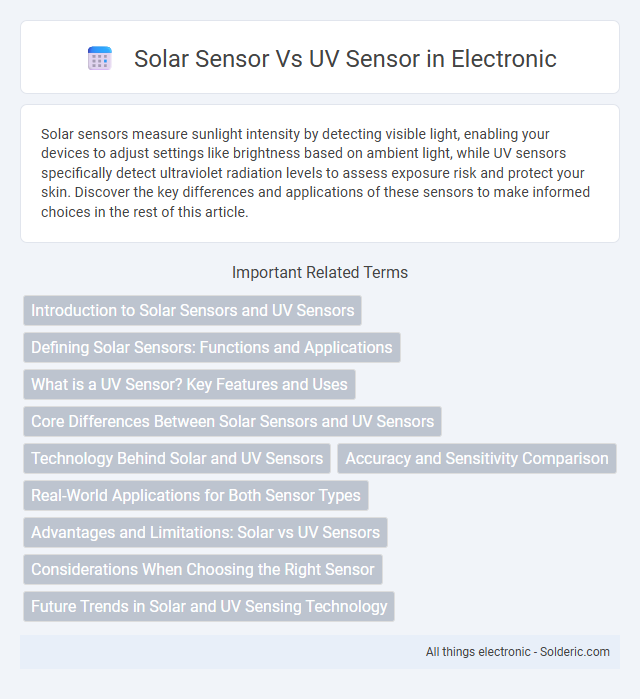Solar sensors measure sunlight intensity by detecting visible light, enabling your devices to adjust settings like brightness based on ambient light, while UV sensors specifically detect ultraviolet radiation levels to assess exposure risk and protect your skin. Discover the key differences and applications of these sensors to make informed choices in the rest of this article.
Comparison Table
| Feature | Solar Sensor | UV Sensor |
|---|---|---|
| Function | Measures solar radiation intensity | Detects ultraviolet (UV) radiation levels |
| Wavelength Range | Broad spectrum (typically 300-1100 nm) | UV spectrum (100-400 nm) |
| Common Applications | Solar panel performance, weather stations | UV index monitoring, skin exposure assessment |
| Output Type | Analog or digital irradiance data | Analog or digital UV intensity data |
| Calibration | Calibrated for total solar irradiance | Calibrated specifically for UV radiation |
| Sensor Examples | Photodiodes, pyranometers | UV photodiodes, UV index sensors |
| Typical Units | W/m2 (watts per square meter) | mW/cm2 or UV index |
| Environmental Sensitivity | Sensitive to total sunlight including visible and infrared | Specifically sensitive to ultraviolet rays, less to visible light |
Introduction to Solar Sensors and UV Sensors
Solar sensors detect ambient light intensity and measure solar radiation to optimize energy efficiency in environments like smart buildings and solar panels. UV sensors specifically measure ultraviolet radiation levels, critical for monitoring UV exposure in health, environmental, and agricultural applications. Both sensors play distinct roles in light measurement but are tailored to different spectra and purposes for precise data collection.
Defining Solar Sensors: Functions and Applications
Solar sensors detect sunlight intensity and direction to optimize energy efficiency in solar panels, adjust lighting systems, and enhance environmental monitoring. These devices measure solar irradiance, enabling precise alignment of photovoltaic cells and automation of shading systems to reduce energy consumption. Common applications include solar tracking in renewable energy installations, smart building controls, and weather stations.
What is a UV Sensor? Key Features and Uses
A UV sensor measures ultraviolet light intensity and detects UV radiation levels from the sun or artificial sources. Key features include spectral range sensitivity typically between 200-400 nm, high accuracy in UV index measurement, and responsiveness to UV-A and UV-B rays, making them essential for monitoring solar radiation exposure and protecting skin health. Common uses involve environmental monitoring, wearable UV protection devices, outdoor lighting control, and scientific research on solar radiation effects.
Core Differences Between Solar Sensors and UV Sensors
Solar sensors measure the intensity of solar radiation across a broad spectrum, including visible light, infrared, and ultraviolet rays, enabling applications in climate monitoring and solar energy management. UV sensors specifically detect ultraviolet radiation levels, crucial for assessing UV exposure risks, protecting skin health, and controlling UV-sensitive devices. Core differences lie in spectral range sensitivity, with solar sensors offering comprehensive solar energy data while UV sensors provide precise ultraviolet radiation monitoring.
Technology Behind Solar and UV Sensors
Solar sensors utilize photodiodes and phototransistors sensitive to broad light spectra to measure solar irradiance by detecting visible and infrared light intensities. UV sensors employ specialized semiconductor materials like silicon carbide or gallium nitride that respond specifically to ultraviolet light wavelengths, enabling precise UV radiation measurements. Both sensor types integrate filtering layers and signal processing units to enhance accuracy and selectivity for their respective light ranges.
Accuracy and Sensitivity Comparison
Solar sensors measure overall solar radiation intensity, providing accurate data for sunlight exposure, while UV sensors specifically detect ultraviolet light, offering higher sensitivity to UV index variations. Solar sensors excel in broad spectrum detection but may lack precise UV responsiveness, whereas UV sensors deliver detailed accuracy in monitoring harmful UV radiation levels. Your choice depends on whether general solar exposure or targeted UV measurement accuracy and sensitivity are priority factors.
Real-World Applications for Both Sensor Types
Solar sensors and UV sensors serve distinct roles in various real-world applications, with solar sensors primarily used in managing energy efficiency for buildings and solar panel positioning systems. UV sensors are crucial for monitoring harmful ultraviolet radiation, benefiting personal health devices, agricultural practices, and environmental monitoring. Your choice between these sensors depends on whether you need to measure overall solar irradiance or specific UV exposure levels for more targeted applications.
Advantages and Limitations: Solar vs UV Sensors
Solar sensors offer broad-spectrum detection of sunlight intensity, providing valuable data for energy management and climate control, but they may lack specificity for UV radiation levels. UV sensors specialize in detecting ultraviolet light, essential for monitoring UV exposure and protecting against harmful effects, yet they can be limited by sensitivity to only specific UV bands. The choice between solar and UV sensors depends on application requirements, balancing solar irradiance measurement with precise UV monitoring for effective environmental and health-related assessments.
Considerations When Choosing the Right Sensor
Choosing between a solar sensor and a UV sensor depends on the specific application requirements such as detecting overall solar radiation or measuring ultraviolet light intensity. Solar sensors are optimized for monitoring total solar energy, making them ideal for energy management and weather stations, while UV sensors provide precise UV index measurements critical for health and environmental monitoring. Sensor accuracy, spectral response range, durability under environmental conditions, and cost are key considerations to ensure optimal performance and data reliability.
Future Trends in Solar and UV Sensing Technology
Advancements in solar sensors emphasize enhanced spectral sensitivity and integration with IoT for real-time environmental monitoring and energy optimization. UV sensors are evolving with improved accuracy in measuring UVA and UVB radiation, critical for health applications and climate research. Future trends highlight miniaturization, increased robustness against environmental factors, and AI-driven data analytics to enable predictive maintenance and adaptive lighting systems.
Solar sensor vs UV sensor Infographic

 solderic.com
solderic.com